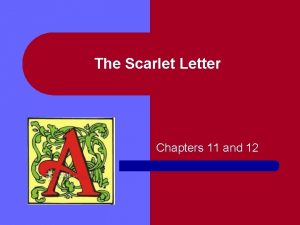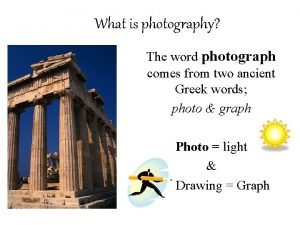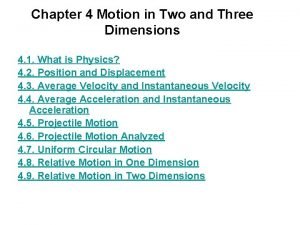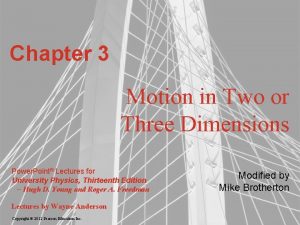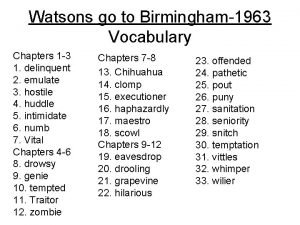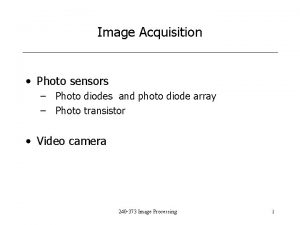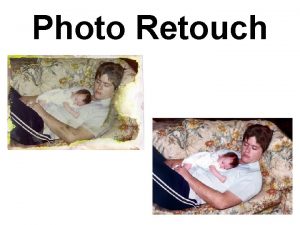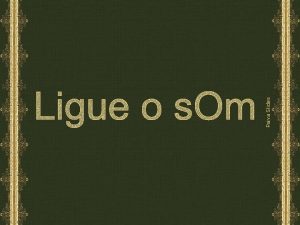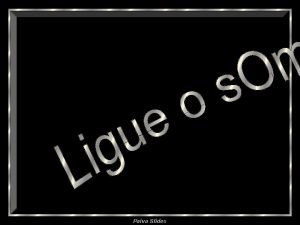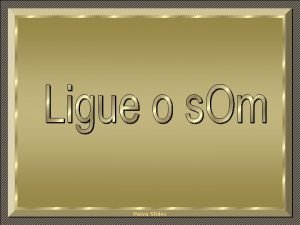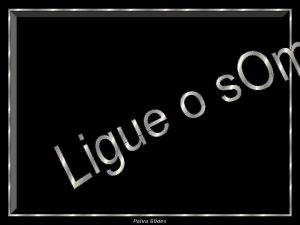Lecture Three Chapters Two and three Photo slides

































- Slides: 33

Lecture Three Chapters Two and three Photo slides from Digital Image Processing, Gonzalez and Woods, Copyright 2002

Chapter 2: Digital Image Fundamentals

Functional Represenation of Images • Two-D function f(x, y), (x, y) pixel position. Postive and bounded • Written as f(x, y)=i(x, y)r(x, y), i(x, y) illumination from light source, r(x, y) reflectance (bounded between 0 and 1) based on material properties. E. g r(x, y)=0. 01 for black velvet, r(x, y) = 0. 93 for snow. • Intensity of monochrome image f(x, y) is synonymous with grey levels. By convention grey level are from 0 to L 1.

Chapter 2: Digital Image Fundamentals

Chapter 2: Digital Image Fundamentals

Spatial and Gray Level Resolution • Spatial resolution is the smallest level of detail discernable in an image. Number of line pairs per millimeter, say 100 line pairs per millimeter. • Gray-level resolution is the smallest discernable change in gray level. Very subjective.

Chapter 2: Digital Image Fundamentals

Chapter 2: Digital Image Fundamentals

Chapter 2: Digital Image Fundamentals

Adjacency and Connectivity • Adjacency- Two pixels p and q are adjacent if q is in N(p) where N(p) is the neighborhood of p and they have closely related pixel values. Three common definitions of neighborhood are (1) 4 -adjacency. If p=(x, y), values are similar, but q is either (x-1, y), (x+1, y), (x, y-1), (x, y+1) (2) 8 -adjacency. It is possible for q to be one of the diagonal points (x-1, y-1), (x-1, y+1), (x+1, y-1), (x+1, x+1). (3) m-adjacency. Either q is 4 -adjacent to p, or q is a diagonal point and the intersection of the four neighborhood of p and that of q have no similar pixel values.

Chapter 3 Image Enhancement in the Spatial Domain

Chapter 2: Digital Image Fundamentals

Adjacency , More Formally Choose a set of gray values V. If f(p) and f(q) are in V, and q is in the right kind of neighborhood of p, then p and q are adjacent. I can model this relationship using 0 -1 images, why? ?

Chapter Three Image Enhancement in Spatial Domain Find gray level transfomration function T(r) to obtain g(x, y) =T(f(x, y)) processed image from input image. Reasons 1. Contrast enhancement 2. Visual improvement 3. Image understanding

Chapter 3 Image Enhancement in the Spatial Domain

Negatives Here T(r) = L-1 -r L-1 maximum gray level Produces photographic negative. Some details are easier to spot if we go from black and white to white and black.

Chapter 3 Image Enhancement in the Spatial Domain

Mammogram Notice that the white or gray detail in the dark region is more visible in the negative. This shows a small lesion.

Chapter 3 Image Enhancement in the Spatial Domain

Log Transformation T(r) = c log(1+s) Inverse Log T(r) = exp(r/c)-1 For the next picture, c=1. Used to display Fourier spectra.

Chapter 3 Image Enhancement in the Spatial Domain

Power Law or Gamma Transformations This the gamma correction

Chapter 3 Image Enhancement in the Spatial Domain

CRT Example CRT devices have intensity to value response functions that are power functions. They vary in exponents from 1. 8 to 2. 5. A logical transformation is

Chapter 3 Image Enhancement in the Spatial Domain

MRI of Fractured Spine Transformation is With gamma = 0. 6, 0. 4, 0. 3

Chapter 3 Image Enhancement in the Spatial Domain

Chapter 3 Image Enhancement in the Spatial Domain

Chapter 3 Image Enhancement in the Spatial Domain

Chapter 3 Image Enhancement in the Spatial Domain

Chapter 3 Image Enhancement in the Spatial Domain

Chapter 3 Image Enhancement in the Spatial Domain

Chapter 3 Image Enhancement in the Spatial Domain
 A small child slides down the four frictionless slides
A small child slides down the four frictionless slides A spring loaded gun shoots a plastic ball
A spring loaded gun shoots a plastic ball Principles of economics powerpoint lecture slides
Principles of economics powerpoint lecture slides Ethem alpaydin
Ethem alpaydin Business communication lecture slides
Business communication lecture slides 01:640:244 lecture notes - lecture 15: plat, idah, farad
01:640:244 lecture notes - lecture 15: plat, idah, farad To kill a mockingbird 10-11 summary
To kill a mockingbird 10-11 summary To kill a mockingbird chapters 1-4 quiz
To kill a mockingbird chapters 1-4 quiz Naughts and crosses summary
Naughts and crosses summary Gatsby chapter 3 summary
Gatsby chapter 3 summary Based on chapters 3 and 4 of the strange case
Based on chapters 3 and 4 of the strange case Charlie and the chocolate factory chapters
Charlie and the chocolate factory chapters Frankenstein chapter 10-11 summary
Frankenstein chapter 10-11 summary Chapters 11 and 12 scarlet letter
Chapters 11 and 12 scarlet letter Pride and prejudice chapter 52
Pride and prejudice chapter 52 Chapters 9 and 10 lord of the flies
Chapters 9 and 10 lord of the flies The scarlet letter chapter 22
The scarlet letter chapter 22 Photo collage about socialization and enculturation,
Photo collage about socialization and enculturation, Look at the pictures and answer the questions below.
Look at the pictures and answer the questions below. Look at the photo. answer the questions
Look at the photo. answer the questions In pairs look at the photos and answer the questions
In pairs look at the photos and answer the questions The word photography comes from the greek words
The word photography comes from the greek words In pairs look at the photos and discuss the questions
In pairs look at the photos and discuss the questions Where does the word photography come from
Where does the word photography come from Characteristics of two dimensional shapes
Characteristics of two dimensional shapes Motion in two and three dimensions
Motion in two and three dimensions A level 3 question
A level 3 question Motion in two or three dimensions
Motion in two or three dimensions The watsons go to birmingham vocabulary chapters 1-4
The watsons go to birmingham vocabulary chapters 1-4 How does morrie feel about music
How does morrie feel about music The catcher in the rye chapter 6 quotes
The catcher in the rye chapter 6 quotes To kill a mockingbird quiz part 1
To kill a mockingbird quiz part 1 What was scouts first crime at school
What was scouts first crime at school Chapter 10-11 to kill a mockingbird summary
Chapter 10-11 to kill a mockingbird summary













